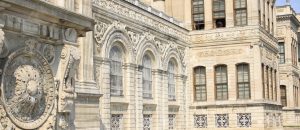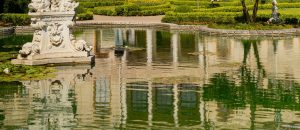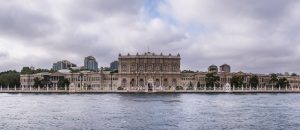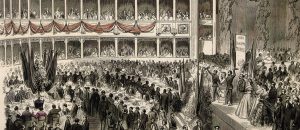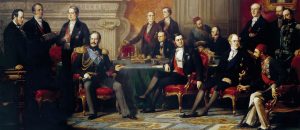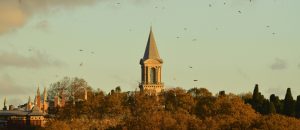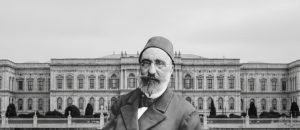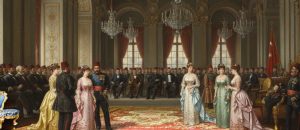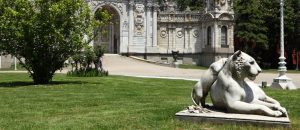Dolmabahçe Palace, although appearing as a single structure, actually possesses two separate, consciously designed faces that address two different audiences. The Dolmabahçe facades facing the sea and the land are the complex identity strategy of the 19th-century Ottoman Empire carved into stone. While the side facing the sea sends a modern, orderly, and powerful message to Europe; the side facing the land presents a message of more controlled change to its own people and traditional institutions. This architectural “two-facedness” is not a weakness, but quite the opposite: it is a sophisticated political communication tool reflecting the delicate balance the empire established between the East and the West. [Link: The general architectural philosophy of Dolmabahçe Palace -> /explore/grand-design-architecture]
The Facade Facing the Sea: The Showcase Opening to Europe
The sea-facing facade of Dolmabahçe Palace is the empire’s showcase opening to the world and was meticulously designed to project an image of a Western power. This facade, with its flawless symmetry, the order brought by the Neoclassical style, and its monumental scale, was planned to impress diplomats, statesmen, and visitors arriving by sea from Europe. Since the sea was the most important route for international travel at that time, the palace’s first and most powerful impression was given through this facade. This was a visual manifesto declaring that the Ottoman Empire was now [Link: an equal part of the European state system -> /mermerden-daha-fazlasi-dolmabahce-mimarisi-neden-avrupaya-gonderilmis-bir-mesajdi].
The facade stretching along 284 meters in uninterrupted integrity symbolizes a centralized and monolithic state structure. The regular window spacing, the majestic columns, and the measured ornamentation on the facade allude to the rational and predictable governance model introduced by the Tanzimat reforms. This face communicates to a European counterpart that it is not a complex and exotic Eastern empire, but a familiar, orderly, and modern monarchy worthy of engagement. The architectural language used here is a universal language of power and prestige.
The Facade Facing the Land: A New Interpretation of Traditional Power
The palace’s facade facing the land—that is, the city and its own people—contains a different and more layered message. This side, which lacks the strict symmetry of the sea facade, has a more fragmented appearance due to the combination of monumental gates and different buildings. This design is a conscious choice. The goal is to show the public and traditional institutions that Westernization was not a radical break, but rather a modern interpretation of imperial tradition. This facade emphasizes the strength and control of the change while also conveying a familiar sense of authority.
The most dominant elements of this facade are the colossal entrances, such as the Imperial Gate (Saltanat Kapısı) and the Treasury Gate (Hazine Kapısı). These gates address a subject or a local official coming from within the city, rather than a visitor arriving from the sea. The monumental scale of the gates re-creates the authority of the Bâb-ı Hümâyûn (Imperial Gate) at Topkapı Palace, but in a modern idiom. Therefore, even while presenting a Western aesthetic, the land facade constructs its message through the empire’s established symbols of power. This is an architectural approach that reflects [Link: the dynamics of modernization in the Ottoman Empire -> https://www.ktb.gov.tr/TR-96388/tanzimat-fermani.html] and the dilemmas it brought.
The Imperial Gate: The Imperial Threshold Opening to the City
The Imperial Gate (Bab-ı Hümayun), located at the center of the land facade, is the architectural element that best symbolizes the transition between the palace’s two faces. Although the gate’s general outline contains Neoclassical and Baroque elements reminiscent of Western triumphal arches, it strongly emphasizes the Ottoman identity with the tughra, muqarnas-like niches, and rich pen work decorations on it. This is the result of an effort to create a symbol of power that is both new and familiar.
The fact that the gate opens directly to the city and connects via a ceremonial route to the Bezmialem Valide Sultan Mosque indicates that the Sultan continued to appear before the public through traditional rituals like the Friday Procession (Cuma Selamlığı). Just as the sea facade is the stage for international diplomacy, the land facade, and especially the Imperial Gate, is the stage for local and traditional rituals of power. This gate is an architectural threshold reminding us that the Sultan is both a modern monarch and a Caliph.
“Two-Facedness” as an Architectural Strategy
This difference between the facades of Dolmabahçe Palace is not an inconsistency or “two-facedness,” but a reflection of the 19th-century Ottoman State’s survival strategy. The Empire had to simultaneously present a modern image to integrate into Europe’s political and economic system, while also holding together its multinational and tradition-bound populace. The architecture of the Palace perfectly embodies this dual strategy.
The sea-facing facade is a public relations campaign aimed at the international community. The land-facing facade is a message of legitimacy and continuity aimed at the domestic public. This situation elevates Dolmabahçe beyond being merely an architectural structure, making it a complex political text whose walls speak in different languages. By reading the subtle differences between these two facades, the visitor can trace the struggle for existence of an empire in the modern world.
Conclusion
In conclusion, the land and sea facades of Dolmabahçe Palace are like the stages of a theater where the empire plays to two different audiences. While the face turned toward the sea conveys a message of modernity, order, and power to the West; the face turned toward the land whispers to its own people that tradition continues and change is under control. This conscious architectural separation makes Dolmabahçe not only an aesthetic achievement but also one of the most sophisticated monuments of 19th-century Ottoman political intelligence and identity search.









